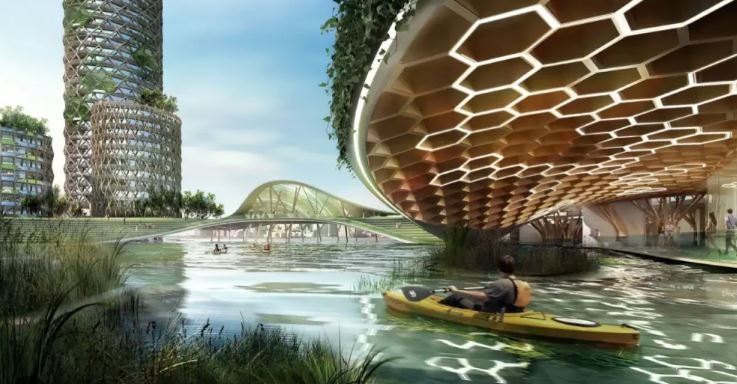The Impact of Climate Change on Architecture:
Climate change poses significant challenges to architectural design, necessitating innovative solutions to mitigate its impact on built environments. This blog examines how climate change influences architectural practices, explores sustainable design strategies, and highlights the importance of using resilient building materials to create environmentally responsible and adaptive structures.

Understanding Climate Change’s Influence on Architecture
Climate change affects architectural design in various ways, primarily through shifts in weather patterns, rising temperatures, and extreme weather events. Architects must consider these factors when designing buildings to ensure resilience, energy efficiency, and occupant comfort. Strategies include passive design techniques, such as orientation, shading, natural ventilation, and thermal mass, which reduce reliance on mechanical systems and minimize energy consumption.
Sustainable Design Strategies
In response to climate change, architects integrate sustainable design strategies that prioritize environmental stewardship and resource efficiency. These strategies encompass:
- Energy-Efficient Building Systems: Incorporating solar panels, energy-efficient HVAC systems, and smart building technologies to reduce carbon emissions and operational costs.
- Water Management: Implementing rainwater harvesting, greywater recycling systems, and low-flow fixtures to conserve water resources and enhance building resilience during droughts.
- Material Selection: Choosing eco-friendly materials with low embodied carbon, such as recycled steel, bamboo, and sustainably sourced timber, to minimize environmental impact throughout a building’s lifecycle.
Resilient Architecture and Building Materials
Resilient architecture focuses on designing buildings that can withstand climate-related risks, including floods, hurricanes, heatwaves, and wildfires. Architects employ resilient building materials like concrete, engineered wood, and insulated glass that offer durability, thermal stability, and fire resistance. Innovations in material science, such as self-healing concrete and bio-based insulation, enhance building resilience while reducing environmental footprint and maintenance costs.
Case Studies in Climate-Responsive Architecture
Cities worldwide showcase climate-responsive architectural solutions that address local environmental challenges. Masdar City in Abu Dhabi exemplifies sustainable urban planning with its use of renewable energy. Integrated green spaces, and passive cooling techniques to combat extreme heat. The Edge in Amsterdam, recognized as the world’s most sustainable office building, utilizes advanced technologies like smart sensors and natural ventilation to optimize energy efficiency and indoor comfort.
Regulatory and Policy Implications
Governments and regulatory bodies play a crucial role in promoting climate-responsive architecture through building codes, zoning regulations, and incentives for green building certification. Policies that encourage energy-efficient designs and resilient construction practices drive industry innovation and support the transition towards sustainable urban development.
Future Challenges and Opportunities
As climate change intensifies, architects face ongoing challenges, including adapting designs to evolving environmental conditions, integrating renewable energy solutions, and fostering community resilience. Opportunities lie in collaborative research initiatives, public-private partnerships, and leveraging digital technologies to advance climate-responsive architecture and mitigate carbon emissions.
Climate change is significantly altering architectural practices by necessitating a shift towards sustainable and resilient design solutions. Architects are increasingly integrating passive design techniques, such as orientation, natural ventilation, and green roofs, to enhance energy efficiency and reduce carbon footprints. The adoption of sustainable building materials, like recycled steel and bamboo, alongside innovative technologies such as solar panels and greywater recycling systems, underscores a commitment to environmental stewardship. Resilient architecture is also gaining prominence, with structures designed to withstand extreme weather events such as hurricanes and heatwaves. These developments not only mitigate the impact of climate change on built environments but also promote healthier, more sustainable urban landscapes that prioritize both human comfort and environmental sustainability.
Conclusion
Climate change fundamentally reshapes architectural practices by emphasizing sustainability, resilience, and innovation in building design. Architects play a pivotal role in creating resilient, energy-efficient structures that mitigate environmental impact. They enhance quality of life for future generations. By embracing sustainable design strategies and resilient building materials, architects contribute to a sustainable futur. Additionally, where buildings not only withstand climate challenges but also thrive in harmony with their surroundings.



